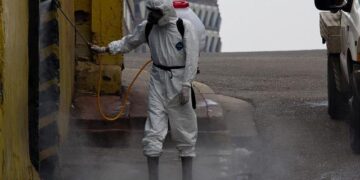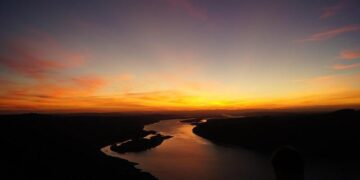Lithium! Is there a hotter element these days? The foundation of our attempt to move anyway from the use of petroleum products for energy sits, at least right now, on lithium and its use in batteries. Li-ion batteries are the core to electric cars, household electrical storage and pretty much any technology that requires the power for long periods. However, the lithium has to come from somewhere, just like all resources from our planet … and unlike petroleum, it isn’t life that is the ultimate source.
Lithium is a weird element. It is the third lightest, with a nucleus of 3 protons. Most of the lithium on Earth is an isotope called lithium-7, meaning the nucleus has 3 protons and 4 neutrons. A small fraction is lithium-6, which has one fewer neutrons.
Elemental Distribution in Universe. Credit: Wikimedia Commons.
Being such a simple element, it turns out that some lithium was produced during the Big Bang along with the hydrogen and helium of the universe. However, thanks to the processes of stellar fusion, lithium is not nearly as abundant as many elements much heavier that it. In fact, the “lithium divot” (see above) in the elemental composition of the universe means that lithium is ~10 million times less abundant than helium (element 2) and 100,000 times less abundant than carbon (element 6).
When the Earth was formed out of the primordial solar nebula, light elements like hydrogen, helium and lithium were mostly left out of the planet’s materials (beyond hydrogen in water). Estimates today suggest the Earth’s crust is about 0.002% lithium, ranking it between such elements as scandium and niobium – not exactly everyday elements.
Mining Lithium Today
Right now, much of the world’s lithium is mined from deposits in Australia and Chile/Argentina. That’s because the places were lithium is mined come in two main flavours: (1) igneous (derived from magma) rock deposits and (2) sedimentary deposits from drying lakes. One of the largest lithium deposits in the world is in the sediments filling the mostly-dry lakebed in Bolivia called the Salar de Uyuni and the Chilean/Argentine deposits are of similar origin. Most of Australia’s deposits are of the “hard rock” variety across Western Australia.
Salt deposits in the Salar de Uyuni in Bolivia. Credit: Wikimedia Commons.
The US … well, it doesn’t currently produce much lithium of its own. There is a single operating lithium mine in Nevada that extracts the element from brines (mineral-rich waters), so it is more like the South American deposits.
The US imports only about 25% of the lithium it uses, but that is a product of actually how little lithium is used in the US. Over 80% of all the global lithium is used to make batteries, but that industry really doesn’t exist in the US right now. In 2022, according to the US Geological Survey, the US used about 3,000 tonnes of lithium. Compare that to China and its lithium battery industry that used over 300,000 tonnes in 2021!
So, the real issue isn’t that China isn’t producing more lithium — it does have some lithium deposits, but it isn’t rich in it. It does, however, process more lithium into batteries than any country in the world. Much of the rules related to EV tax credits in the US are linked to moving this production and processing of lithium from China to the US and its allies.
The US is investing almost $2 billion into identifying lithium deposits so that the country can expand from its single current lithium mine. Multiple new deposits have been identified, mainly in the western US. One of them appears to be the current “mother lode” of lithium and possibly the largest lithium deposit on the planet.
The Volcano That Erupted Lithium
Major lithium deposits across the world (right) and the location of the McDermitt Caldera in Oregon/Nevada (right). Credit: Benson et al. (2017), Nature Communications.
The McDermitt caldera is located along the Oregon-Nevada border. It can be consider the great-great-great grandfather of the Yellowstone Caldera meaning it was one of the first identified manifestations of the mantle plume that currently sits under Wyoming. During the time that the McDermitt caldera was active between 15 and 17 million years ago, it produced some huge explosive volcanic eruptions topping at over 1000 cubic kilometers of ash and debris.
Thanks to the somewhat unique chemistry of these volcanic deposits, the McDermitt caldera eruptions set into motion a series of geologic processes that resulted it incredibly rich lithium deposits. This all adds up to the potential for over 20-40 million metric tons of lithium resources in the caldera area — an amount that would move the US into the top of lithium suppliers globally. The history of the deposit was recently detailed in a research paper by Thomas Benson and others in Science Advances.
The lithium in the McDermitt caldera ended up there in a fortuitous fashion. First, you needed an eruption that could form a caldera. This happened about 16.3 million years when the McDermitt caldera was formed during an eruption that would rival the biggest from the modern Yellowstone caldera.
Thanks to the magma being formed partially by incorporating the North American crust underneath the area, elements like lithium were enriched in the molten rock. Once the eruption happened, half of that 1000 cubic kilometers spilled out away from the area as pyroclastic flows while the other half fell into the caldera formed by the collapse of the land during the eruption.
Layers of sediment from a lake that formed in the McDermitt Caldera. Credit: Henry et al. (2017), Geosphere.
Now you have ~500 cubic kilometre of hot volcanic debris in a closed basin (the caldera). As it begins to cool, the basin fills with water and sediment, leaching some of the lithium out of the volcanic debris and enriching it in the sediment. Then, as volcanism continuing in (and especially under) the caldera, hot fluids come up through faults and fractures, leaching even more lithium and keeping parts of the sediment warm.
In doing so, you perform a magic trip. You convert one type of magnesium rich clay into a lithium rich clay (called illite). The clays are being made by the breakdown of volcanic glass and minerals in the caldera, but then they get enriched in lithium due to hydrothermal alteration — the process where heated fluids can add or remove elements.
Did the US Hit the Mother Lode of Lithium?
In the end, the McDermitt caldera area has clays that are upwards of 5 to 12 weight percent lithium! That is a lot of lithium concentrated into these clay minerals. When considering the size and thickness of the lake sediments containing these clays, the size of the lithium deposit could be multiple times larger than the Salar de Uyuni deposit, the current world champion for lithium resources.
Of course, none of this is without consequence. There are clearly environmental impact questions that need to be answered about how the lithium can be minded and processed. It uses a lot of water and damages the surface ecosystem to create the open pit mines. What would the point of doing this be if lithium extraction creates as much local or global environmental damage as the stuff it is meant to be replacing? These questions don’t have answers right now.
However, we do know that there is immense pressure to create better lithium reserves for the US and the McDermitt caldera could be a first step towards that. Solving the problems of potential environmental damage from utilising this lithium may be the next big step now that we’ve pinpointed a place where we might get this rare element.
>>> Read full article>>>
Copyright for syndicated content belongs to the linked Source : Discover Magazine – https://www.discovermagazine.com/planet-earth/the-quest-for-lithium-deposits-hits-a-potential-jackpot






























